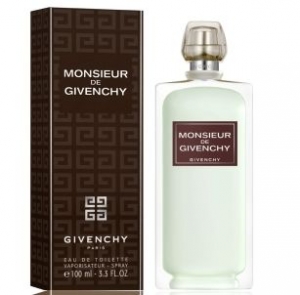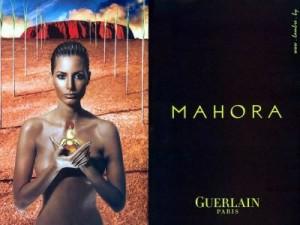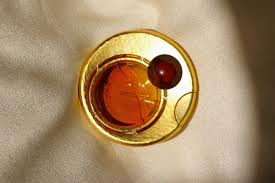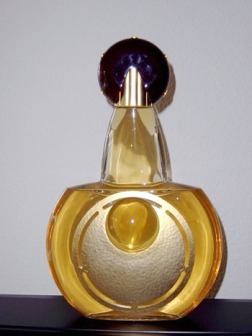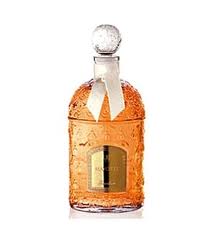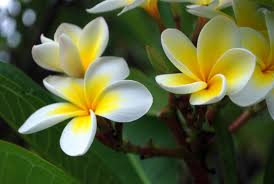I like to wear men’s colognes. I admit that quite proudly. In fact, the modern commercial trend towards generic sugar bombs and gourmands has made me resort more and more to men’s cologne of late. So, from time to time, I will post brief reviews or impressions of ones I enjoy. One of them, deeply ingrained in the memories of my childhood, is the 1959 classic, Monsieur de Givenchy (which I’ll just call “Vintage” or “MdG-V” from now on) by  Givenchy. My father used to wear it, along with a number of other classic, legendary men’s fragrances. (In fact, it’s thanks to my father that I ever developed a nose for men’s cologne to begin with!) Recently, a dear friend of mine recently sent me a very large decant of the vintage version, circa 1970s judging by his box. And it was as amazing as I remember.
Givenchy. My father used to wear it, along with a number of other classic, legendary men’s fragrances. (In fact, it’s thanks to my father that I ever developed a nose for men’s cologne to begin with!) Recently, a dear friend of mine recently sent me a very large decant of the vintage version, circa 1970s judging by his box. And it was as amazing as I remember.
Being inquisitive and also lucky to have a father with a nice selection of colognes, I decided to poke through his current collection. There, I saw a new-ish bottle of Monsieur de Givenchy (hereinafter “Modern” or “MdG-M” with the “M” standing for “Modern.”) My father dates it to about 2004 or 2005. So, I temporarily stole his bottle and decided to do a side-by-side comparison. Bottom line: I think there is clearly a huge, HUGE difference between the two fragrances. And one of them is terrible.
First, I need to make a point of clarification about the different versions. MdG may have been reformulated a few times over its 50 year history. The array of boxes shown on different Basenotes threads could be a hint of that.
(I’ve seen at least 3 different ones.) Making matters more complicated, Basenotes states that Givenchy issued a fragrance called “Monsieur de Givenchy II” in 1993 as an updated version of the classic, but then discontinued it, before finally just re-issuing it as Greenergy. It is a totally different scent. So too is Givenchy Gentleman (1974). Givenchy Gentleman and Monsieur de Givenchy are complete opposites. The Gentleman is heavier with patchouli and leather, while the MdG is a citrus chypre. If you’re still with me, I fear I may lose you when we get to 2007.
2007 was when Givenchy launched Les Parfums Mythiques – Monsieur de Givenchy Givenchy for men, a fragrance that has very different ingredients listed.
For example, the carnation, cinnamon, and pepper in the top notes are now gone. And, by all reports, the oakmoss heart has been so diluted that it has essentially vanished. Despite these huge changes, Les Mythiques appears to have completely replaced the MdG — whatever its prior formulations. Adding to this belief is the fact that Givenchy’s Mythiques line consists of a number of its classical colognes like Xeryus and Vetyver; it would seem to be a complete rebranding and modernisation of all its oldest fragrances. So, for the purposes of this review, when I refer to “MdG-M,” I’m referring to the final version of Monsieur (1990s to 2006) prior to its reformulation as Les Mythiques. And the Vintage version refers to the 1970s/80s formulation (or older) that is the true MdG, in my opinion.
One thing I can assure you: you can easily find the Vintage version on eBay. And, in this case (perhaps even more than usual), the vintage version is best. It is absolutely something you will want to seek out if you love aromatic citrus scents that are very discreet. But onward and upwards, to the fragrances themselves.
MdG (in all its permutations) is commonly classified as “Citrus Aromatic.” Its notes are not so clear beyond the basics which are: lemon, lavender, bergamot and sandalwood. The details, however, vary from site to site. Fragrantica lists the notes for MdG-V as follows: “Top: carnation, cinnamon, pepper and lemon; middle notes are lavender and lemon verbena; base notes are sandalwood, musk and oakmoss.”
Basenotes has even less details, with no reference to the carnation and cinnamon, let alone the geranium and civet that I know is there. NST has a much more complete list, though it’s completely unclear to me which version of MdG they’re talking about. Nonetheless, this is how NST described the original scent:
A hesperides lover’s dream come true, Monsieur is composed of bergamot, lemon, lime, petitgrain, lavender, clary sage, orange, basil, musk, civet and cedar. Don’t worry — if it sounds herbal, it is, but only slightly.
That’s for the Vintage version. In contrast, the notes for the Modern version are a quarter of that. Fragrantica lists them as follows: “Top notes are bergamot and lemon; middle notes are lavender and lemon verbena; base notes are hinoki wood and oakmoss.” (I have absolutely no idea what “hinoki wood” is, but Google informs me that it’s Japanese cypress.) My father’s bottle of MdG-M essentially lists the same, only with the inclusion of “coumarin” (a classic Fougère element), oak moss “extract,” and “cinnamal.” (No sight of anything resembling “hinoki,” by the way.) Observe how different the ingredient list for the Modern scent is from both Fragrantica and NST’s listings for the vintage. For the Vintage, I think we should go with NST’s fuller version of the ingredients because they seem much more accurate to my nose.
I put on a 3-4 average splashes of the Vintage (circa 1970s or early 1980s) on my right arm, and about 3-4 sprays of Modern (circa 2004) on the left. From the very opening splash of the Vintage, I got a sparkling, super bright explosion of green. Green, green and more green, but never in a linear, one-note manner. There was lemon, verbena and mossy greens with depth, complexity and a lovely herbal note. In contrast, my 3-4 squirts of the Modern led me to actually mutter out loud: “What the hell is this???!” It was watery and diluted beyond belief. The difference was mind-boggling.
There was such a wimp factor that I hurriedly sprayed 2 more bursts, then an additional 2 to 3 for good measure. So, now, I’ve got about 7 or 8 sprays of the Modern on my left arm and about 3-4 good splashes of the Vintage on the right. And I still smell the Vintage more! The Modern version was all watery lemon with absolutely no oakmoss from the onset. After 15 minutes, I suppose you can say that it had turned into lemon-lavender soap. I suppose. There is really so little to say about it.
In contrast, the Vintage version had started to open up. The lemon, verbena and oakmoss accords began to include geranium and lavender. They emerged quite prominently, along with the carnation and a faint touch of soap. I wonder if I can smell the sage and basil, or if I’m imagining it, but it doesn’t matter. Oh, lordie, is that geranium lovely! I can smell no cinnamon or orange, but I’m glad for it because I think it would detract from the lovely green, herbal woodiness. The petit-grain also helps in creating that impression. (Petit-grain is the result of distilling the twigs from citrus trees, creating a bitter, woody, masculine scent.) The result is an incredibly balanced, harmonious and sophisticated composition that oozes elegance and class.
An hour in, the vintage version has turned to a lemon lavender musk with soap, some lingering geranium and wood (especially the cedar). There is also some warmth. The musk, civet and sandalwood start a quiet purr. Some have said that the vintage contains real santal oil, and I can believe it because there is a real depth and richness to the warmth.
I think these base notes are what separate MdG-V from another fragrance that it is often compared to: Chanel‘s classic, Pour Monsieur (1955). Pour Monsieur is much, much soapier. It’s also greener and has spice (ginger, cardamon, coriander, basil) at its base, while there is none in MdG. Instead, MdG-V has warmth (sandalwood) and musk (civet). MdG-V is actually closer to Dior‘s legendary Eau Sauvage (1966) in its vintage form.
However, it is all very discreet. Verrrrrrrrrrrrrrrrrrrrrry discreet. Everyone always says that MdG is fleeting (in all its formulations), and that is especially true on me. While most give the vintage about 4-5 hours in longevity, on me it starts to seriously fade 2 hours in. A little after the fourth hour, I can smell it faintly on the skin only if I touch my nose to my arm and inhale forcefully.
In contrast, the MdG-M version died about 2 hours in. Died completely, if I may add. Dead as a door nail. And I have little to say about the rest of its development prior to that point. I think it’s an utterly undistinguished, worthless, and watery scent that is easily superceded by most drugstore lemon-lavender soaps. Yes, there is a hint of civet that adds some muskiness later down the line but, really, this thing is a travesty to the name of Monsieur de Givenchy! Others think that there is no difference between vintage MdG and its later incarnations but… bah, humbug! Not in my opinion. (And one can only shudder to think of how bad the Mythiques version must be, given the reports of even further dilution.)
However, I firmly believe that the MdG-Vintage is worth a small effort to track down on eBay. I am usually someone who opts for orientals, spice and warmth, but I can’t help but really like MdG-V. Despite its limited sillage and fleeting longevity, it’s pure class and refinement. I see MdG as something Cary Grant would wear with a Saville Row bespoke grey suit, double-breasted and with a discreet ,white pochette.
And, yet, I hear that it was Freddie Mercury’s signature scent. Freddie Mercury! Queen! Tight, red leather pants, a bare, hairy chest, bouche à pipe lips, and hot, smoldering sexuality! Freddie Mercury, the original sexpot rebel that Adam Lambert only wishes he could be. Freddie Mercury and MdG!!! Honestly, there aren’t enough exclamation points to convey the incongruity of that pairing in my mind. One thing is for certain: it proves that MdG is not necessarily your grandfather’s cologne. So, if you like herbal citrus colognes and you’re in the market for a refined office scent that is both sophisticated and elegant, you may want to consider this one.
But I don’t promise that anyone will think you’re Freddie Mercury….


